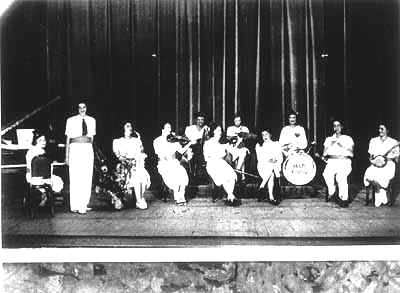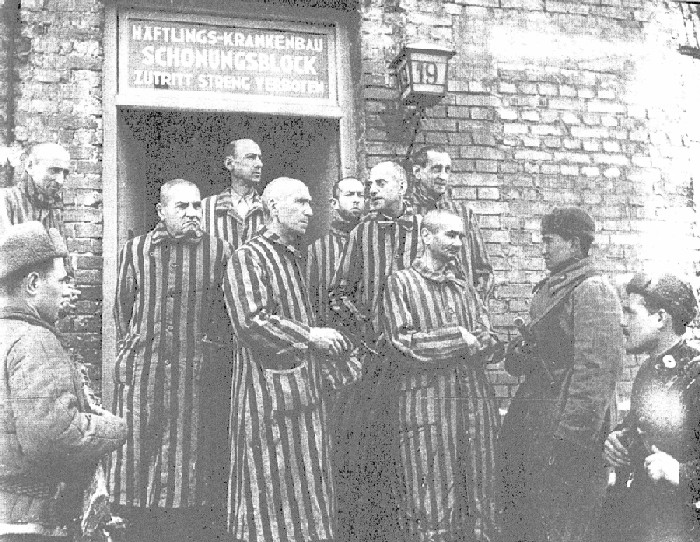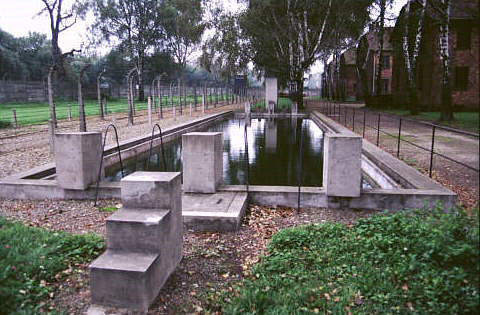Violently incompatible stories swirl about the little town of Oswiecim/Auschwitz, as if two quite different places had somehow managed to co-exist there, sixty years ago. These stories cannot all be true. The United Nations has requested that Holocaust Memorial Day be commemorated on January 27th - the day the Auschwitz camp was ‘liberated’ in 1945. Let us make a website to honour this day, i.e. one which will hold a memory of the Auschwitz camp. It could somewhat resemble major ‘Holocaust Memorial Day’ sites (eg, http://www.hmd.org.uk/about/), but its focus would be on the titanic struggle between Lies and the Truth.
To counteract the Greatest Lie Ever Told, I suggest focusing on concrete details of how the wartime labour-camp functioned. For example, an aesthetically elegant swimming-pool clearly exists, and was built by the inmates. Unable to deny this, the authorities have erected a sign saying, ‘Fire brigade reservoir built in the form of a swimming pool.’ This absurd notice is also given in Hebrew - but even that won’t make it true.
Let us hope for the publication in English of a proper book about what the camp was like. Was there really an in-camp court and jail functioning (opposite the gynaecological facility)? Can we hear more about the marriages conducted at Auschwitz, the pregnancies there, the 3,000 live births recorded at the maternity hospital, and how did the child care day-centre work? There might be a problem with finding a publisher …
1. Jacque Pressac’s magnum opus Auschwitz (1988), choc-a-block with plans and diagrams, somehow omitted mention of the swimming-pool in the camp [1]. Built by the inmates, it had a diving board and 'starters' blocks for races. Inmates would sunbathe beside it on Saturday and Sunday afternoons, while watching the water-polo matches [2].
2. Still today, we can view the paintings from its art class. [3] These may be somewhat melancholic (after all, two-and-a-half million tons of bombs were being dropped onto central Europe by the US/UK, targeting the cities) yet no means do they express despair.
3. The camp library had some forty-five thousand volumes for inmates to choose from, plus a range of periodicals.
4. Inmates were paid for their labour and services while interned at Auschwitz concentration camp [Berg, 2006], and special money was printed for their use.[4] Through extra work inmates could obtain such coupons, redeemable for cake or ice cream in the Camp Cantina.
5. There were six camp orchestras [5] at Auschwitz/Birkenau alone, one of which contained no less than 100-120 musicians. The Jerusalem Post recorded one inmate’s memory, of singing in its choir the Beethoven’s 9th Chorale [6]. In 1943, Daniel K (now a professor) was only 10 years old, and as such he participated in the children’s choir ‘I … remember my first engagement with culture, with history, and with music – in the camp.’
6. Also theatrical performances, including a children’s opera, were held at the centre. A camp theatre, where a rather saucy review was held on Saturdays [7]. Today a convent of Carmelite nuns dwells there. The last pictures taken inside showed pianos and costumes and a stage where the inmates used to put on productions.
7. Birkenau at Auschwitz had its own soccer field, with weekly games between the SS staff and camp inmates, and a central sauna. There was also fencing class. The football field was adjacent to the site of alleged human gassing (i.e. the morgue, according to the design plans) so its hard to see how this fiendish process could have been carried on in secret, as normally alleged.
8. At the weekly camp cinema, mainly cultural and non-political films were shown.
9. Legal advice was available to the inmates, in relation to any non-natural deaths. The SS-men were not allowed to hit prisoners – and commander Hoess had a standing order that any inmate could approach him personally to register a complaint.
10. Some 4,800 sick prisoners were under medical care [8]. There was an inmates dental unit. The surgical block was very modern for the time (Elie Wiesel was operated on there, as described in his Night essay) and expert surgeons from the famous Berlin "Charité" surgical clinic were dispatched to deal with difficult cases. The cook-houses provided "dietetic cooking" for some of the sick, with "special soups and even a special bread." [9]
11. Visitors were free to come and go at the Auschwitz camps, eg visits of the wives of the inmates took place.
12. In the summer of 1943 the camp brothel was established just inside the main gate, on Himmler’s orders, to reward privileged prisoners, with medical checkups before each visit. [10].
13. Women’s sections of the camps had female guards.
14. Letters to and from the outside world were collected twice weekly. A postcard sent from Auschwitz [11] dated 18 February, 1942 by Johann Klausa expresses the hope that his family is in good health and hopes they will write to him - he was eventually released from the camp, on 27 November, 1943. Considering that Klausa arrived in the camp on 25 June 1940, he sounds quite cheerful.
15. The Education Centre: In March 1944 Daniel K. became severely ill with diphtheria and was transferred to the camp’s hospital barracks.
One of the youth leaders of our group … asked to establish an education centre for children. He was given permission, and in a short time the education centre became a spiritual and social centre for the family camp. It was the soul of the camp. There were discussions of various ideologies – Zionism, Socialism, Czech nationalism, .. There was a conductor named Imré .. who organised the children’s choir. Rehearsals were held in a huge washroom barracks where the acoustics were good …[12]
16. Microwave delousing As part of the struggle against typhus, the cyanide-gas delousing method (using Zyklon-B) was partially replaced by micro-wave delousing process in May, 1943. State-of-the-art technology was thus taking place at Auschwitz, developed by the Siemens company, described by Germar Rudolf as ‘the world’s first technological predecessor to the microwave ovens in common use today.’[13] Birkenau was the largest labour complex in the Reich and therefore received this special treatment. Owing to Allied bombing its implementation was delayed and it did not become operational until the summer of 1944. It turned out to be highly effective, rendering clothing sterile and vermin-free in minutes.
I consulted the author Carlo Mattogno [14] on the above list of items and he replied (16.6.07) ‘I have verified the affirmations on the basis of documents.’ That gives me confidence in posting this! But, do please write if you believe any of the statements above are incorrect. Any more details, or other sources supporting these points, will be gratefully appreciated.
The Monowitz labour camp at Auschwitz was concerned with synthetic rubber production, and the degree to which this functioned effectively would indicate the level of camp morale. Birkenau was more an internment camp for gypsies, women and children, the chronically ill and those incapable of labour, also a transit camp [15].
References
1. David Irving’s 1991 edition of The Leuchter Report first published an image of this pool.
2. http://www.heretical.com/miscella/swimpool.html
3. Auschwitz art: http://judicial-inc.biz/Auschwitz.htm
4. http://www.codoh.com/gcgv/gcgvcole.html
5. http://judicial-inc.biz/Auschwitz.htm http://www.cympm.com/orkest.html
6. Georges Theil, Heresy, In twenty-first Century France 2006 p.54.
7. 25 Jan 1995, Jerusalem Post Domestic Edn., The Rudolf Report 2003, p.49.
8. Data from the Auschwitz trial at Frankfurt, read out at the trial of General Remer on 22 October 1992 by his lawyer Hajo Hermann: The Rudolf Report, p.360.
9. Mark Klein, De l'Université aux camps de concentration: Télmorgnages 1947, p.26, quoted by Robert Faurisson, ref.2.
10. http://downwithjugears.blogspot.com/200 ... hwitz.html
11. http://www.ety.com/HRP/pol/auschwitzauction.htm
12. Ref. 6
13. The Rudolf Report p.73.
14.author of, Auschwitz – end of a Legend, a Critique of Pressac, 1994
15.W. Staeglich, Auschwitz – a Judge Looks at the Evidence IHR 1986








